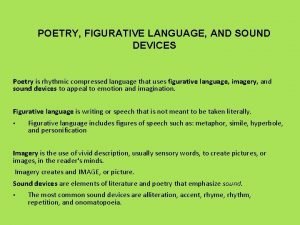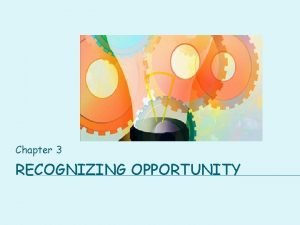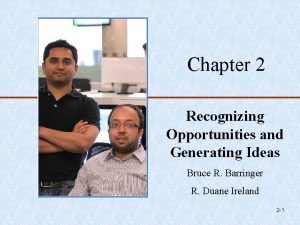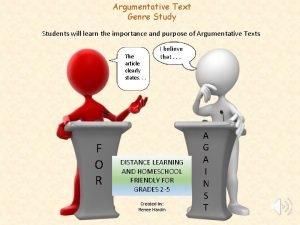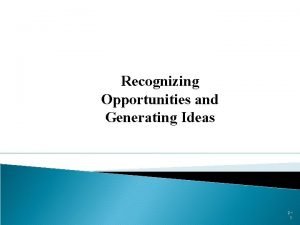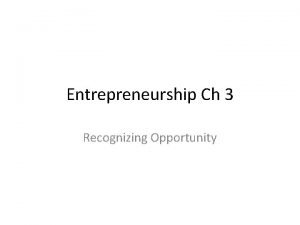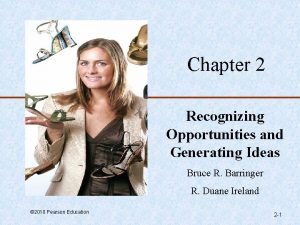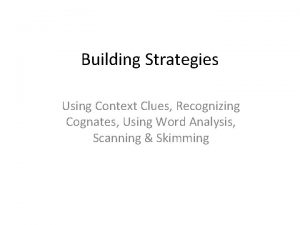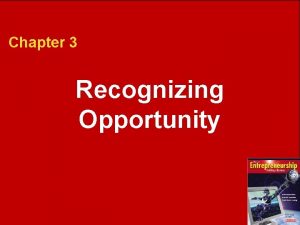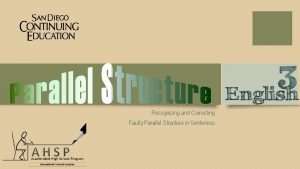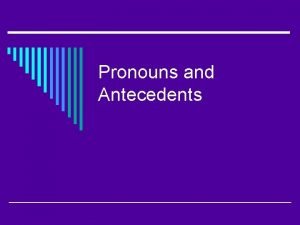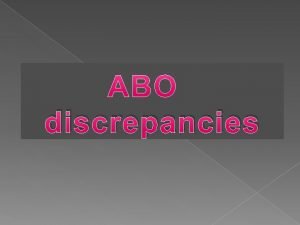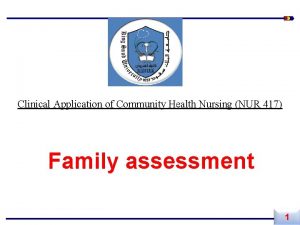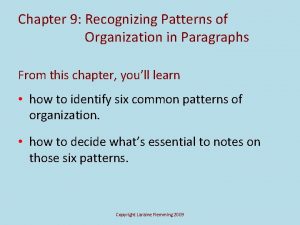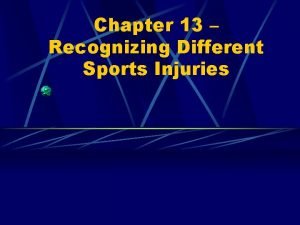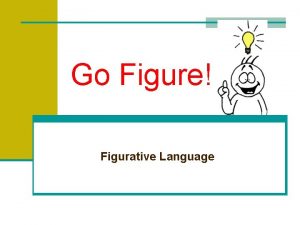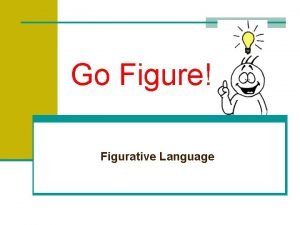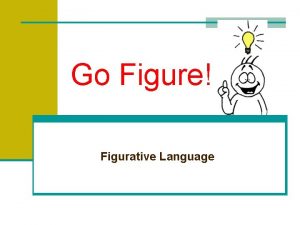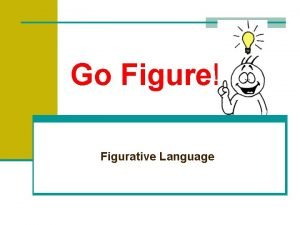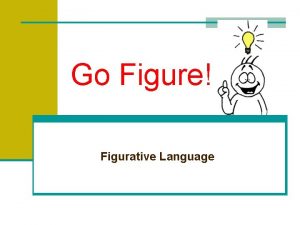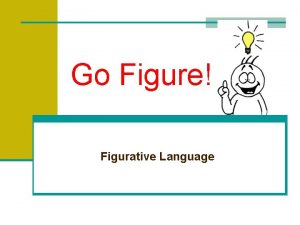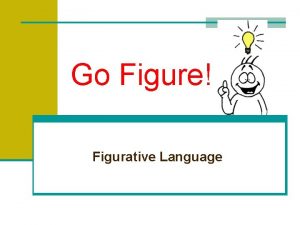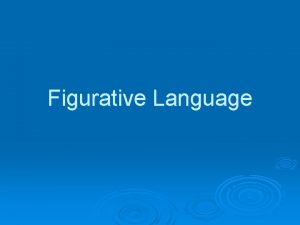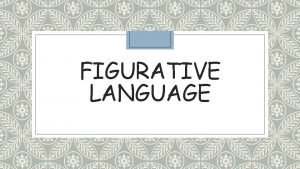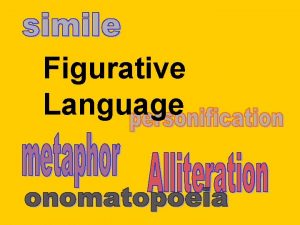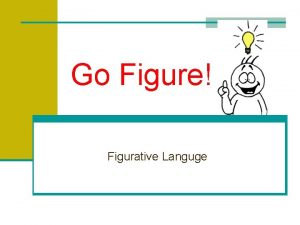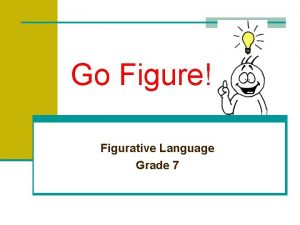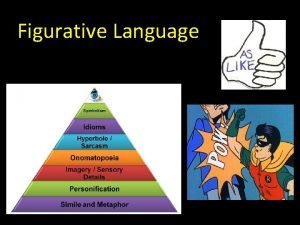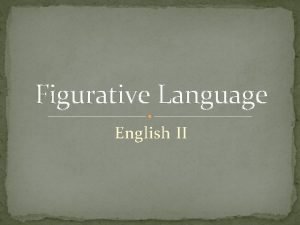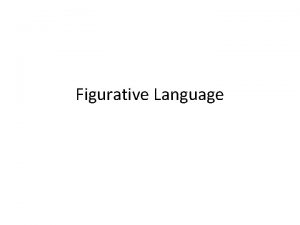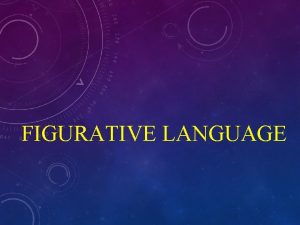Go Figure Figurative Language Presentation Recognizing Figurative Language




















- Slides: 20

Go Figure! Figurative Language Presentation

Recognizing Figurative Language The opposite of literal language is figurative language. Figurative language is language that means more than what it says on the surface. n It usually gives us a feeling about its subject. n Poets use figurative language almost as frequently as literal language. When you read poetry, you must be conscious of the difference. Otherwise, a poem may make no sense at all.

Recognizing Literal Language “I’ve eaten so much I feel as if I could literally burst!” n In this case, the person is not using the word literally in its true meaning. Literal means "exact" or "not exaggerated. " By pretending that the statement is not exaggerated, the person stresses how much he has eaten. Literal language is language that means exactly what is said. Most of the time, we use literal language.

What is figurative language? n Whenever you describe something by comparing it with something else, you are using figurative language.

Imagery n Language that appeals to the senses. Descriptions of people or objects stated in terms of our senses. • Sight • Hearing • Touch • Taste • Smell

Imagery (examples) On a starry winter night in Portugal Where the ocean kissed the southern shore There a dream I never thought would come to pass Came and went like time spent through an hourglass” “ -Teena Marie, Did you notice how descriptive the lyrics are?

Simile n A figure of speech which involves a direct comparison between two unlike things, usually with the words like or as. Example: The muscles on his brawny arms are strong as iron bands.

Metaphor n A figure of speech which involves an implied comparison between two relatively unlike things using a form of be. The comparison is not announced by like or as. Example: The road was a ribbon wrapped through the dessert.

Alliteration n Repeated consonant sounds occurring at the beginning of words or within words. Example: She was wide-eyed and wondering while she waited for Walter to waken.

More Advanced Examples Great giants groan greatly on green grass. Pretty princesses parade proudly passing people. Huge horses have heavy hoofs. Merry Mary misses many Monday movies. Prince Peter picks pretty pansies for princesses. Mean monsters make magnificent meatloaf. Fast fat frogs franticly find flies. Eddie eagerly eats eleven Easter eggs. Cheerful Carl creatively colors calico cats.

Personification n A figure of speech which gives the qualities of a person to an animal, an object, or an idea. Example: “The wind yells while blowing. " The wind cannot yell. Only a living thing can yell.

Onomatopoeia n The use of words that mimic sounds. Example: The firecracker made a loud ka-boom!

Hyperbole n An exaggerated statement used to heighten effect. It is not used to mislead the reader, but to emphasize a point. Example: She’s said so on several million occasions.

Idioms n An idiom or idiomatic expression refers to a construction or expression in one language that cannot be matched or directly translated word-for-word in another language. Example: "She has a bee in her bonnet, " meaning "she is obsessed, " cannot be literally translated into another language word for word.

Oxymoron n a combination of words that have opposite or very different meanings. n Examples: n Pretty ugly n Jumbo Shrimp

Irony n When the unexpected happens

Symbolism Symbol is using an object or action that means something more than its literal meaning. *The practice of representing things by means of symbols or of attributing symbolic meanings or significance to objects, events, or relationships.

Symbol (examples)

Allusion is a brief reference to a person, event, or place, real or fictitious, or to a work of art. Casual reference to a famous historical or literary figure or event. An allusion may be drawn from history, geography, literature, or religion.

Allusion (example) n “I was surprised his nose was not growing like Pinocchio’s. ” This refers to the story of Pinocchio, where his nose grew whenever he told a lie. n “When she lost her job, she acted like a Scrooge, and refused to buy anything that wasn’t necessary. ” Scrooge was an extremely stingy character from Charles Dickens’, A Christmas Carol. n “This place is like a Garden of Eden. ” – This is a biblical allusion to the “garden of God” in the Book of Genesis. n “Stop acting like my ex-husband please. ” – Apart from scholarly allusions we refer to common people and places in our speech.
 Figurative language that uses sounds
Figurative language that uses sounds Reflection of
Reflection of Listening for specific details top down or bottom up
Listening for specific details top down or bottom up Recognizing opportunity
Recognizing opportunity Trends and opportunities examples
Trends and opportunities examples Argumentative text anchor chart
Argumentative text anchor chart The distribution objective must be congruent with:
The distribution objective must be congruent with: Recognising opportunities
Recognising opportunities Recognizing lab safety worksheet answer
Recognizing lab safety worksheet answer Entrepreneurial trends
Entrepreneurial trends An opportunity has four essential qualities it is
An opportunity has four essential qualities it is Strategy: recognizing cognates
Strategy: recognizing cognates What is the genre of an essay
What is the genre of an essay Chapter 3 recognizing opportunity
Chapter 3 recognizing opportunity Recognizing laboratory safety
Recognizing laboratory safety Recognizing parallel structure
Recognizing parallel structure Whats antecedents
Whats antecedents Recognizing and resolving abo discrepancies
Recognizing and resolving abo discrepancies Recognizing interruptions of health development
Recognizing interruptions of health development Patterns of paragraph organization
Patterns of paragraph organization Chapter 13 worksheet recognizing different sports injuries
Chapter 13 worksheet recognizing different sports injuries
